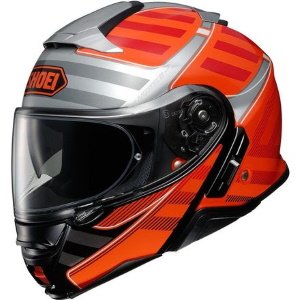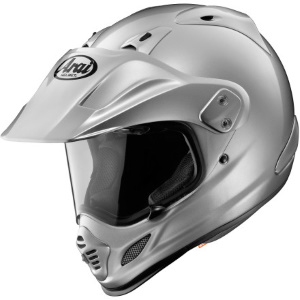
The most effective and important safety measure a motorcyclist can invest in is the helmet. No other single piece of motorcycle gear provides more protection, or more return on investment, in the event of a crash. This explains why a motorcycle helmet should not be bought based on the price or appearance. A rider should buy the best fitting, most highly rated helmet he or she can afford.
Buying a helmet requires a bit of research to understand the different shapes and how to buy the best fit. In this motorcycle helmet sizing guide we cover the following essential aspects to choosing the correct motorcycle helmet:
But first, it's important to know a little about safety ratings. All helmets approved for use in the United States come with Department of Transportation (DOT) rating. Other safety ratings include Snell and the Economic Commission for Europe (ECE). Snell and ECE tend to have more rigorous testing but that doesn't mean a DOT-only approved helmet is any less safe for highway travel. You can read more about safety ratings by reading The Big List of DOT, Snell & ECE Approved Motocross Helmets.
The bottom line is the best helmet is the one that fits is comfortable and allows you to ride without inhibiting your range of motion or ability to perform the necessary functions to safely operate a motorcycle.
Shape
The most important helmet fitting aspect to consider before determining helmet size is helmet shape. The shape of the rider's head plays a crucial role in selecting a proper fitting motorcycle helmet. All helmet manufacturers design their lids to fit a specific head shape. These often range across three primary designations - long oval, intermediate oval, and round oval.
- Long Oval - Shaped for a head which is longer front-to-back (from forehead to the back of the skull) than it is side-to-side (ear to ear).
- Intermediate Oval - Shaped for a head which is slightly longer front-to-back than it is side-to-side. Most motorcycle helmets will fall into this category as it is the most common head shape; if a helmet does not state its shape, this is usually it.
- Round Oval - Shaped for a head which has almost identical front-to-back and side-to-side measurements.
Once the head shape is determined, it is easier to filter the enormous selection of available motorcycle helmets down to a smaller, more appropriate list of those which will fit the rider's head. Now it is time to find the correct size of the motorcycle helmet.
Sizing a Motorcycle Helmet
Measuring for motorcycle helmet size is as simple as looking for a good fitted hat. The difference is in how the helmet fits over the rider's head. The best tool for this is a seamstress or tailor's tape measure. It is flexible enough to wrap around the rider's skull and marked in useful increments for determining an accurate size. Use it to find which size of helmet suits you:
- Wrap the measuring tape around the fullest part of the head - this will be just above the ears and about a half-inch above the eyebrows for most - and take the measurement at the forehead. To get the most accurate measure, have a friend help with this step.
- Take the measurement and compare to the size chart on the page for the desired motorcycle helmet (you might have to scroll down). Each manufacturer has sizing which is specific to its own models, so only rely on the size chart produced for the motorcycle helmet being considered.
Some variance occurs, even between different models from the same manufacturer, which is why MotoSport offers a "Free First Exchange" program if your helmet does not fit properly.
Example of a motorcycle helmet size chart
Helmet Fit
When a new helmet is first worn, it should actually be slightly tight, with the interior coming into contact with most of the head, but not so restrictive that it causes any pain. There should be no "hot spots" - places where the helmet's interior puts pressure on specific points of the skull or face - but it should not move around freely. With time, a helmet adjusts to match the shape of the rider's head as it is worn, "breaks-in" and loosens a little. However, it should never become loose enough to easily turn from side to side.
- Put the helmet on - it should be a little tight as it goes on over the head.
- The helmet should sit on the head evenly with the eye port's upper edge just above the eyebrows and offer good peripheral vision to see side-to-side.
- Put a finger between the helmet interior and the head. If it easily fits, try a smaller size. Some helmet models allow a change in the cheek pads for better fitment, so consider this when checking for proper sizing.
Finally, when deciding on a helmet style - it's mostly up to personal choice for color, patterns and shield tint but remember the brighter and easier to see a helmet the more likely drivers spot a rider. The face shield should not obscure the rider's vision in any way and tinted visors should only be used for sunny days.
Types of Motorcycle Helmets
Motorcycle helmets come in different types, or styles, each offering certain benefits to address a rider's needs. Some riders like full all-around protection while others prefer a slim approach that mostly allows them to ride legally in those states that have helmet laws. Regardless, you have many options to choose from:
Clearly, deciding on the best motorcycle helmet can be a bit daunting. Read Picking the Best Motorcycle Helmet which discuss these helmets a bit more in-depth and asks some questions that help you narrow down the best style of helmet for your riding style. Meanwhile, some popular suggestions in the riding community include:
ICON Airflight - Full Face Helmet
Shoei Neotec II - Modular Helmet
Arai XD4 - Dual Sport Helmet
HJC IS 5 - Open Face Helmet
Fly Racing 9MM - Half Shell Helmet
Conclusion
A well-fitting motorcycle helmet contributes to a safer and more comfortable ride. If the helmet does not fit right, it can cause pain which often leads to dangerous distractions, and it may not completely protect the rider's head in a crash. Therefore, finding a motorcycle helmet which fits the rider correctly is very important to the helmet's twin missions of comfort and safety. Spend enough time finding the right helmet and you will find that the helmet almost disappears while wearing and yet it is right where it needs to be should the ride go wrong. Be smart. Be safe. Ride with a correctly sized motorcycle helmet and enjoy the road for years to come.














